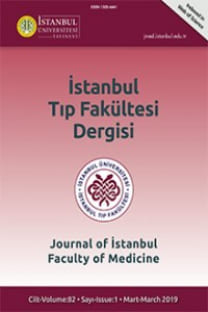ÇOCUKLUK ÇAĞINDA PRİMER VE SEKONDER PSÖDOTÜMÖR SEREBRİ SENDROMU-BAŞVURU SEMPTOMLARI VE BEYİN GÖRÜNTÜLEME BULGULARI
Çocuk, psödotümör serebri, idyopatik intrakranial hipertansiyon
PRIMARY AND SECONDARY PSEUDOTUMOR CEREBRI SYNDROME IN CHILDHOOD: SYMPTOMS AND IMAGING FINDINGS
Child, pseudotumor cerebri, idiopathic intracranial hypertension,
___
- 1. Standridge SM. Idiopathic intracranial hypertension in children: a review and algorithm. Pediatr Neurol 2010;43(6):377-90.
- 2. Friedman DI, Liu GT, Digre KB. Revised diagnostic criteria for the pseudotumor cerebri syndrome in adults and children. Neurology 2013;81(13):1159-65.
- 3. Markey KA, Mollan SP, Jensen RH, Sinclair AJ. Understanding idiopathic intracranial hypertension: mechanisms, management, and future directions. Lancet Neurol 2016;15(1):78-91.
- 4. Paley GL, Sheldon CA, Burrows EK, Chilutti MR, Liu GT, Mccormack SE. Overweight and obesity in pediatric secondary pseudotumor cerebri syndrome. Am J Ophthalmol 2015;159(2):344-52.e1.
- 5. Görkem SB, Doğanay S, Canpolat M, Koc G, Dogan MS, Per H, et al. MR imaging findings in children with pseudotumor cerebri and comparison with healthy controls. Childs Nerv Syst 2015;31(3):373-80.
- 6. Değerliyurt A, Teber S, Karakaya G, Güven A, Şeker ED, Arhan EP, et al. Pseudotumor cerebri/idiopathic intracranial hypertension in children: an experience of a tertiary care hospital. Brain Dev 2014;36(8):690-9.
- 7. Per H, Canpolat M, Gümüş H, Poyrazoğlu HG, Yıkılmaz A, Karaküçük S, et al. Clinical spectrum of the pseudotumor cerebri in children: etiological, clinical features, treatment and prognosis. Brain Dev 2013;35:561-8.
- 8. Babikian P, Corbett JJ, Bell W. Idiopathic intracranial hypertension in children: The Iowa experience. J Child Neurol 1994;9(2):144-9. 9. Balcer LJ, Liu GT, Forman S, Pun K, Volpe NJ, Galetta SL, et al. Idiopathic intracranial hypertension: relation of age and obesity in children. Neurology 1999;52(4):870-2.
- 10. Tibussek D, Schneider DT, Vandemeulebroecke N, Turowski B, Messing-Juenger M, Willems PH, et al. Clinical spectrum of the pseudotumor cerebri complex in children. Childs Nerv Syst 2010;26(3):313-21. 11. Brara SM, Koebnick C, Porter AH, Langer-Gould A. Pediatric idiopathic intracranial hypertension and extreme childhood obesity. J Pediatr 2012;161(4):602-7. 12. Kesler A, Fattal-Valevski A. Idiopathic intracranial hypertension in the pediatric population. J Child Neurol 2002;17(10):745-8. 13. Sağlam H, Tarım Ö. Prevalence and correlates of obesity in school children from the city of Bursa, Turkey. J Clin Res Pediatr Endocrinol 2008;1(2):80-8.
- 14. Glatstein MM, Oren A, Amarilyio G, Scolnik D, Tov AB, Yahav A, et al. Clinical characterization of idiopathic intracranial hypertension in children presenting to the emergency department: the experience of a large tertiary care pediatric hospital. Pediatr Emerg Care 2015;31(1):6-9. 15. Aylward SC, Aronowitz C, Reem R, Rogers D, Roach ES. Intracranial hypertension without headache in children. J Child Neurol 2015;30(6):703-6. 16. Hacifazlioglu Eldes N, Yilmaz Y. Pseudotumour cerebri in children: etiological, clinical features and treatment modalities. Eur J Paediatr Neurol 2012;16(4):349-55. 17. Rangwala LM, Liu GT. Pediatric idiopathic intracranial hypertension. Surv Ophthalmol 2007;52(6):597-617. 18. Phillips PH, Repka MX, Lambert SR. Pseudotumor cerebri in children. J AAPOS 1998;2(1):33-8. 19. Faz G, Butler IJ, Koenig MK. Incidence of papilledema and obesity in children diagnosed with idiopathic ‘’benign’’ intracranial hypertension: case series and review. J Child Neurol 2010;25(11):1389-92.
- 20. Beri S, Gosalakkal JA, Hussain N, Balky AP, Parepalli S. Idiopathic intracranial hypertension without papilledema. Pediatr Neurol 2010;42(1):56-8. 21. Wall M, Kupersmith MJ, Kieburtz KD, Corbett JJ, Feldon SE, Friedman DI, et al. The idiopathic intracranial hypertension treatment trial. JAMA Neurol 2014;71(6):693-701. 22. Wall M, White WN. Asymmetric papilledema in idiopathic intracranial hypertension: prospective interocular comparison of sensory visual function 2nd. Invest Ophthalmol Vis Sci 1998;39(1):134-42.
- 23. Degnan AJ, Levy LM. Pseudotumor cerebri: brief review of clinical syndrome and imaging findings. AJNR Am J Neuroradiol 2011;32(11):1986-93.
- Yayın Aralığı: 4
- Başlangıç: 1916
- Yayıncı: İstanbul Üniversitesi Yayınevi
LEİOMYOMLARIN MEDİKAL TEDAVİSİ
Funda GÜNGÖR UĞURLUCAN, Ömer DEMİR, Cenk YAŞA, Özlem DURAL
Ertuğrul ERKEN, Özlem KUDAŞ, Suzan DİNKÇİ, Yunus Emre KUYUCU, Türker TAŞLIYURT, Eren ERKEN
BİRİNCİ PARMAK ARALIĞI KONTRAKTÜRLERİNİN BİLOBE FLEPLER İLE TEDAVİSİ
Hasan Utkan AYDIN, Ömer BERKÖZ, Atakan AYDIN, Türker ÖZKAN
Gonca BEKTAŞ, Edibe PEMBEGÜL YILDIZ, Tuğçe AKSU UZUNHAN, Nur AYDINLI, Mine ÇALIŞKAN, Meral ÖZMEN
DENEYSEL SİYATİK SİNİR HASARINDA SELENYUMUN AKSON VE MİYELİN İYİLEŞMESİ ÜZERİNE ETKİLERİ
Zahir KIZILAY, Haydar Ali ERKEN, Serdar AKTAŞ, Nevin ERSOY, Burçin İrem ABAS, Abdullah TOPÇU, Çiğdem YENİSEY, Özgür İSMAİLOĞLU
